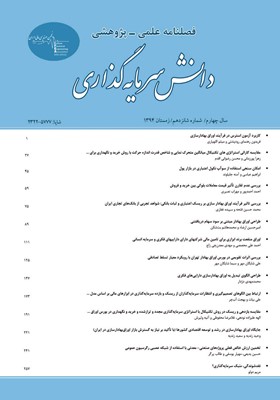بررسی اثر شوک سیاست پولی و مالی بر ارزش افزوده بخش صنعت و معدن در ایران
محورهای موضوعی : دانش سرمایهگذاریعلیرضا برادران 1 , غلامرضا زمردیان 2
1 - دانشجوی دکتری مالی–بانکداری دانشگاه آزاد اسلامی واحد علوم و تحقیقات، تهران، ایران (نویسنده مسئول)
2 - استادیار عضو هیات علمی دانشکده مدیریت دانشگاه آزاد اسلامی تهران مرکزی
کلید واژه: شوک سیاست پولی و مالی, ارزش افزوده بخش صنعت, فیلتر هودریک - پرسکات, الگوی ARDL,
چکیده مقاله :
صنعت از بخش های مهم و حیاتی اقتصاد کشورها محسوب می شود که توجه به آن جزء اهداف جوامع توسعه یافته و در حال توسعه است. در ایران نیز بر اساس آمارها بخش صنایع و معادن در مجموع حدود 25 درصد از تولید ناخالص ملی را به خود اختصاص داده است. با وجود این سهم، صنعت در اقتصاد کشور طی دوران اجرای برنامه های توسعه و سیاست های تعدیل و تثبیت، از سیاست های کلان اقتصادی و به خصوص سیاست های پولی و مالی تاثیر فراوان پذیرفته است. با این رویکرد، مطالعه حاضر اثر شوک سیاست پولی و مالی بر ارزش افزوده بخش صنعت را طی دوره 93-1370 بررسی نموده است. جهت دسترسی به این هدف ابتدا نوسانات سیاست پولی و مالی در قالب فیلتر هودریک - پرسکات، الگوسازی و سپس به کمک مدل ARDL، اثرات آن ها بر ارزش افزوده بخش صنعت در کنار متغیرهایی چون موجودی سرمایه خالص بخش صنایع و معادن، نیروی کار شاغل در این بخش و هزینههای آموزش و پرورش مورد بررسی قرار گرفت. نتایج حاصل از مطالعه حاضر بیانگر آن است که شوک مثبت سیاست پولی و مالی اثری مثبت بر ارزش افزوده بخش صنعت دارد؛ اما شوک منفی سیاست پولی و مالی با ایجاد سردرگمی در میان فعالان اقتصادی، اثری منفی بر ارزش افزوده بخش صنعت می گذارد. همچنین نتایج نشان میدهد که موجودی سرمایه و نیروی کار شاغل در بخش صنعت و معدن بر ارزش افزوده این بخش اثری مثبت دارند. بر این اساس می توان گفت 10 درصد افزایش در موجودی سرمایه و نیروی کار، طی دوره بلندمدت ارزش افزوده بخش صنعت و معدن را به ترتیب به میزان 3/7 و 6/5 درصد افزایش می دهد. در نهایت نیز نتایج بیان گر آن است که مخارج دولتی سرانه در آموزش و پرورش نیز اثری مثبت بر ارزش افزوده بخش صنعت دارد؛ به طوری که 10 درصد افزایش در مخارج دولتی سرانه، طی دوره بلندمدت سبب افزایش ارزش افزوده بخش صنعت به میزان 4/3 درصد میگردد.
Industry is one of the important parts of the countrys economic that attention to it is the goals of developed and developing countries. In Iran, according to the Statistics, Industries and Mines sector has been allocated about 25 percent of GDP to itself. Despite this contribution, the industry during the implementation of development programs and policies of adjustment and stabilization has been effected from macro-economic policies, especially monetary and fiscal policies. With this approach, the present study has been investigated the effect of shocks in monetary and fiscal policy on value added of industry and mining sector in Iran during 1991-2013. To reach this goal, firstly the monetary and fiscal policy shocks was modeled in framework of Hodrick and Prescott filter. Then using the ARDL model, the effects of monetary and fiscal policy shocks on value added of industry and mining sector along with variables such as net capital stock of industries and mines, labor employed in this sector and the costs of education were examined. The results of this study showed that a positive shock of monetary and fiscal policy has a direct impact on the value added of industry sector; But the negative shock of monetary and fiscal policy, has a negative effect on the value added of the industry. The results also revealed that the capital stock and labor employed in industry and mining sector have a positive effect on the value added of this sector. Accordingly, it can be said that 10 percent increase in the capital stock and labor, increase the value-added of industry sector 7.3 and 5.6 percent in the long term, respectively. Finally, the results indicated that per capita government spending on education has also a positive impact on the value added of industry sector; So that 10 percent increase in per capita government spending, increase the value-added of industry sector 3.4 percent in the long term.


